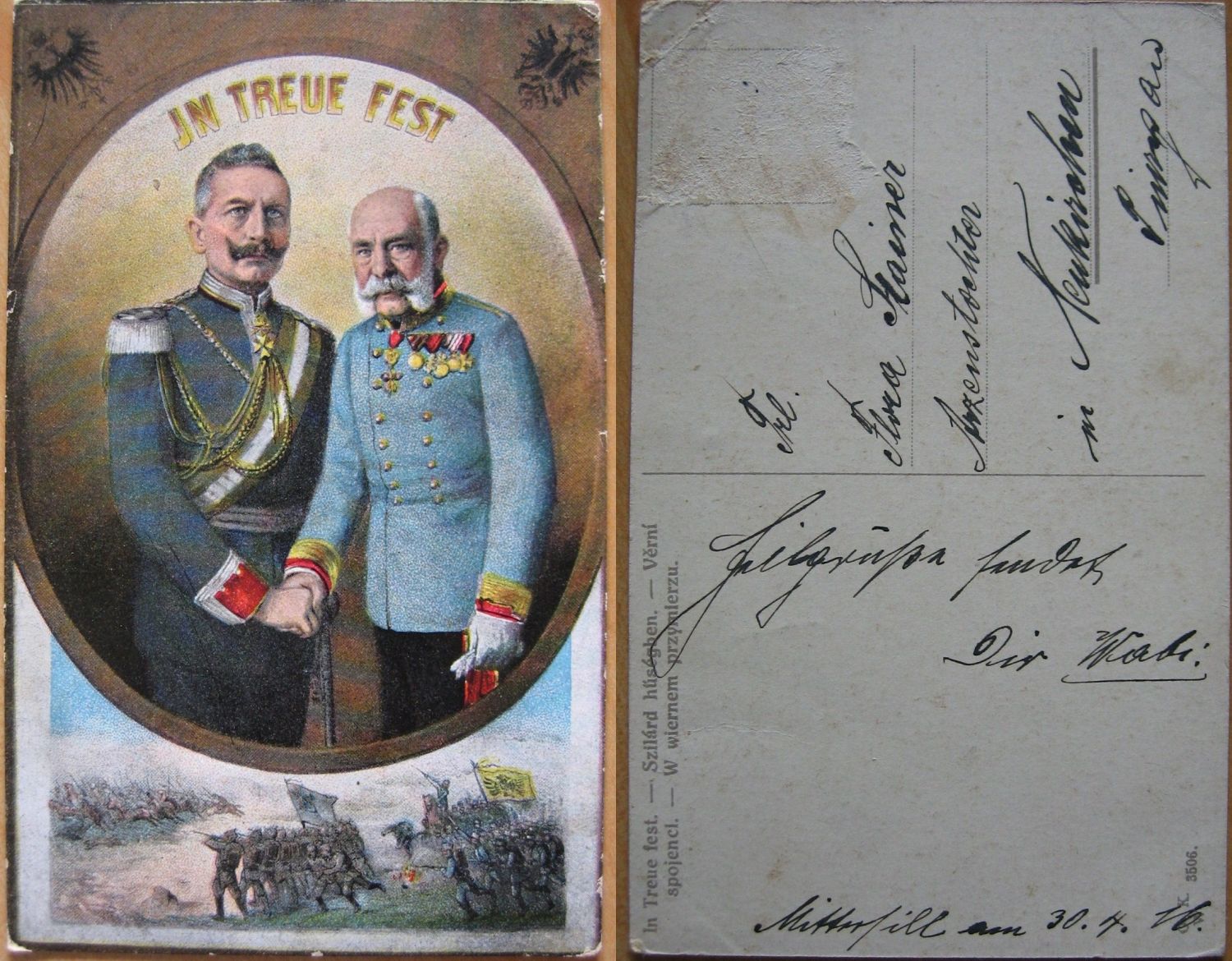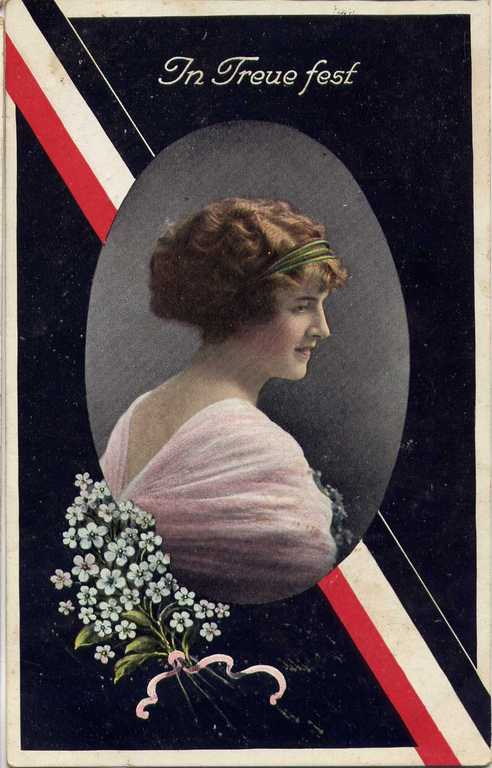In Treue Fest on:
[Wikipedia]
[Google]
[Amazon]

 ''In Treue fest'' (
''In Treue fest'' (
p. 102
*Carl Teike " In Treue Fest " (*mp
* ''In Treue fest. Kriegsbilder aus Ost und West''. Mainz, Scholz, ca. 1916. Quer 4°. "Künstler - Bilderbücher Nr. 14?", drawings by Franz Müller Münster Kingdom of Bavaria Military of Bavaria House of Wittelsbach Monarchism in Germany National mottos Military mottos Mottoes of orders of chivalry Order of Saint Hubert

 ''In Treue fest'' (
''In Treue fest'' (German
German(s) may refer to:
* Germany (of or related to)
** Germania (historical use)
* Germans, citizens of Germany, people of German ancestry, or native speakers of the German language
** For citizens of Germany, see also German nationality law
**Ge ...
for " steadfast in loyalty; firm in fidelity") was the motto
A motto (derived from the Latin , 'mutter', by way of Italian , 'word' or 'sentence') is a sentence or phrase expressing a belief or purpose, or the general motivation or intention of an individual, family, social group, or organisation. Mot ...
of the Kingdom of Bavaria
The Kingdom of Bavaria (german: Königreich Bayern; ; spelled ''Baiern'' until 1825) was a German state that succeeded the former Electorate of Bavaria in 1805 and continued to exist until 1918. With the unification of Germany into the German ...
(1805–1918) and of its Wittelsbach
The House of Wittelsbach () is a German dynasty, with branches that have ruled over territories including Bavaria, the Palatinate, Holland and Zeeland, Sweden (with Finland), Denmark, Norway, Hungary (with Romania), Bohemia, the Electorate ...
rulers, after the end of World War I used by Bavarian monarchists.
The motto originates as that of the Order of Saint Hubert
The Royal Order of Saint Hubert (german: Sankt Hubertus Königlicher Orden), or sometimes (german: Königlicher Orden des Heiligen Hubertus) is a Roman Catholic dynastic order of knighthood founded in 1444 or 1445 by Gerhard VII, Duke of Jülic ...
of the Dukes of Jülich and Berg, rendered in 15th-century Lower Franconian as ''in traw vast''. The order was defunct during the 17th century, and revived in 1708 under Johann Wilhelm, by which time the Duchy of Jülich-Berg had passed to the Palatinate branch of the House of Wittelsbach. The order was brought to Bavaria
Bavaria ( ; ), officially the Free State of Bavaria (german: Freistaat Bayern, link=no ), is a state in the south-east of Germany. With an area of , Bavaria is the largest German state by land area, comprising roughly a fifth of the total lan ...
in 1778 when Charles Theodore, Duke of Jülich and Berg and Count-Elector Palatine, succeeded his childless cousin, Maximilian III Joseph as Elector of Bavaria
The following is a list of rulers during the history of Bavaria. Bavaria was ruled by several dukes and kings, partitioned and reunited, under several dynasties. Since 1949, Bavaria has been a democratic state in the Federal Republic of Germ ...
. In 1799, Charles Theodore was succeeded by Maximilian I Joseph of Bavaria
Maximilian I Joseph (german: Maximilian I. Joseph; 27 May 1756 – 13 October 1825) was Duke of Zweibrücken from 1795 to 1799, prince-elector of Bavaria (as Maximilian IV Joseph) from 1799 to 1806, then King of Bavaria (as Maximilian I Joseph) ...
, a member of a different branch of the house of Wittelsbach, who became the first king of Bavaria
King of Bavaria was a title held by the hereditary Wittelsbach rulers of Bavaria in the state known as the Kingdom of Bavaria from 1805 until 1918, when the kingdom was abolished. It was the second time Bavaria was a kingdom, almost a thousand ...
.
The motto is the title of two military marches
In medieval Europe, a march or mark was, in broad terms, any kind of borderland, as opposed to a national "heartland". More specifically, a march was a border between realms or a neutral buffer zone under joint control of two states in which diff ...
, one by Carl Teike (1903, English title "Steadfast and True") and another by August Högn
August Högn (2 August 187813 December 1961) was a German teacher, composer and historian.
Biography
August Högn was born on 2 August 1878, the middle of five children to married bookbinders Andreas and Helene Högn in Deggendorf. Like all ...
(1905). It is invoked in the final verse of the '' Argonnerwaldlied'' (1914).
From 1909, the motto was embossed on the belt buckles of Bavarian troops. During the First World War
World War I (28 July 1914 11 November 1918), often abbreviated as WWI, was one of the deadliest global conflicts in history. Belligerents included much of Europe, the Russian Empire, the United States, and the Ottoman Empire, with fightin ...
, the motto was frequently reproduced on postcards and other memorabilia, often with the portraits of emperors Wilhelm II
, house = Hohenzollern
, father = Frederick III, German Emperor
, mother = Victoria, Princess Royal
, religion = Lutheranism (Prussian United)
, signature = Wilhelm II, German Emperor Signature-.svg
Wilhelm II (Friedrich Wilhelm Viktor ...
and Franz Joseph I
Franz Joseph I or Francis Joseph I (german: Franz Joseph Karl, hu, Ferenc József Károly, 18 August 1830 – 21 November 1916) was Emperor of Austria, King of Hungary, and the other states of the Habsburg monarchy from 2 December 1848 until his ...
. The "fidelity" invoked in the motto was now interpreted as referring to the loyalty of the German Empire and Austria-Hungary
Austria-Hungary, often referred to as the Austro-Hungarian Empire,, the Dual Monarchy, or Austria, was a constitutional monarchy and great power in Central Europe between 1867 and 1918. It was formed with the Austro-Hungarian Compromise of ...
to their alliance of 1879 in view of the increasing political isolation of the Central Powers
The Central Powers, also known as the Central Empires,german: Mittelmächte; hu, Központi hatalmak; tr, İttifak Devletleri / ; bg, Централни сили, translit=Tsentralni sili was one of the two main coalitions that fought in ...
on the eve of the Great War.
Bernhard von Bülow invoked the mutual loyalty between Germany and Austria-Hungary in 1909 as '' Nibelungentreue'' in his ''Reichstag'' speech of 29 March 1909.
After the First World War it became the motto of German monarchists and of veteran associations also outside of Bavaria. Thus, ''IN TREUE FEST'' is inscribed on the war memorial
A war memorial is a building, monument, statue, or other edifice to celebrate a war or victory, or (predominating in modern times) to commemorate those who died or were injured in a war.
Symbolism
Historical usage
It has ...
in Sörhausen, Syke, Lower Saxony
Lower Saxony (german: Niedersachsen ; nds, Neddersassen; stq, Läichsaksen) is a German state (') in northwestern Germany. It is the second-largest state by land area, with , and fourth-largest in population (8 million in 2021) among the 16 ...
.
In 1921, the Bavarian nationalist and royalist league ''In Treue fest'' was founded at the Sterneckerbräu. It was banned by the Nazis on 2 February 1933, and later re-established in 1952.
Because of its association with monarchism, the motto unlike other German military slogans (notably the term ''Nibelungentreue'') remained unassociated with Nazi ideology
Nazism ( ; german: Nazismus), the common name in English for National Socialism (german: Nationalsozialismus, ), is the far-right totalitarian political ideology and practices associated with Adolf Hitler and the Nazi Party (NSDAP) in Na ...
and is still in use by a number of German associations, including ''Tambourcorps "In Treue fest"'' ( Anstel, founded 1919/20),
''Neusser Tambourkorps "In Treue fest"'' (Neuss
Neuss (; spelled ''Neuß'' until 1968; li, Nüss ; la, Novaesium) is a city in North Rhine-Westphalia, Germany. It is located on the west bank of the Rhine opposite Düsseldorf. Neuss is the largest city within the Rhein-Kreis Neuss district. It ...
, founded 1968).
Bavarian Studentenverbindung
(; often referred to as Verbindung) is the umbrella term for many different kinds of fraternity-type associations in German-speaking countries, including Corps, , , , and Catholic fraternities. Worldwide, there are over 1,600 , about a thousan ...
''KBStV Rhaetia München'' (founded 1881) uses the motto ''cum fide virtus'' ("virtue with loyalty"), intended as a Latin translation of the Wittelsbacher motto;
''KStV Alamannia Tübingen
Tübingen (, , Swabian: ''Dibenga'') is a traditional university city in central Baden-Württemberg, Germany. It is situated south of the state capital, Stuttgart, and developed on both sides of the Neckar and Ammer rivers. about one in three ...
'' uses the Latin translation ''In fide firmitas'' ("steadfastness in loyalty").
See also
*Monarchism in Bavaria after 1918
Monarchism in Bavaria after 1918 was driven by the belief that a monarchy would be the best form of government for the German state of Bavaria, despite the abolition of the Bavarian monarchy in 1918. The Bavarian monarchy ended with the declaration ...
*Bayernhymne
The Bayernhymne (Hymn of Bavaria) is the official anthem of the Free State of Bavaria.
History
The melody of the song was written by Max Kunz in 1835. The text for the original first three stanzas was written by Michael Öchsner. Both men wer ...
*'' Semper fidelis''
References
{{reflistSources
*Joost Augusteijn, Storm. H. J., ''Region and State in Nineteenth-Century Europe: Nation-Building, Regional Identities and Separatism'', Palgrave Macmillan, 2012p. 102
*Carl Teike " In Treue Fest " (*mp
* ''In Treue fest. Kriegsbilder aus Ost und West''. Mainz, Scholz, ca. 1916. Quer 4°. "Künstler - Bilderbücher Nr. 14?", drawings by Franz Müller Münster Kingdom of Bavaria Military of Bavaria House of Wittelsbach Monarchism in Germany National mottos Military mottos Mottoes of orders of chivalry Order of Saint Hubert